
|


Dangerous Water
|

|
|

|

Hitler's Sunken Secret homepage
|
| |

|
| |
To Norwegian Resistance fighters during World War II, heavy water
was a mysterious substance considered so perilous that they were
willing, under orders from the Special Operations Executive in
London, to sacrifice the lives of their countrymen in order to keep
it out of Nazi hands. Learn more about heavy water—its
discovery, uses, and why it remains a threat today—by clicking
on the images above or simply scrolling down.—Susan K. Lewis
|
|

|
|
|
What is it?
Heavy water is a form of water with a unique atomic structure and
properties coveted for the production of nuclear power and weapons.
Like ordinary water—H20—each molecule of
heavy water contains two hydrogen atoms and one oxygen atom. The
difference, though, lies in the hydrogen atoms. In ordinary water,
each hydrogen atom has just a single proton in its nucleus. In heavy
water, each hydrogen atom is indeed heavier, with a neutron as well
as a proton in its nucleus. This isotope of hydrogen is called
deuterium, and heavy water's more scientific name is deuterium
oxide, abbreviated as D20.
|
|

|
With the weight of extra neutrons, heavy-water ice will
sink to the bottom of a beaker filled with ordinary
H20.

|
|
|
|
|
How is it Used in Nuclear Power Plants?
Nuclear power plants harness the energy of countless atoms of
uranium splitting apart, or fissioning, in a chain reaction. Heavy
water can help keep such a chain reaction going. As each uranium
atom breaks apart, it shoots out neutrons that can go on to split
other atoms. But the neutrons are much more likely to trigger new
fission events if they are slowed down. Like traffic cops, heavy
water's deuterium atoms effectively curb the pace of neutrons
without capturing them.
Nuclear reactors that use heavy water can employ a form of uranium
commonly found in nature (U-238) rather than requiring so-called
enriched uranium, which contains a higher percentage of easily split
uranium atoms (U-235) but is expensive to produce.
|
|
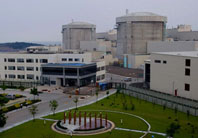
|
Heavy-water nuclear reactors generate electricity in
China (above), Canada, and India. No commercial plants
in the U.S. use heavy water.

|
|
|
|
|
Why is it Dangerous?
In its natural state, common uranium (U-238) can't generate
destructive nuclear explosions. It either must be
enriched—made more concentrated in a rare form of uranium
(U-235)—or converted into plutonium (Pu-239). Heavy water can
play a role in breeding weapons-grade plutonium from common uranium.
In a heavy-water nuclear reactor, when neutrons bombard U-238, some
uranium atoms absorb an additional neutron and are transformed into
Pu-239.
On the eve of World War II, scientists both in Germany and Great
Britain realized that heavy water could be used in this way to make
nuclear weapons. And because this potential still exists today, the
International Atomic Energy Agency and various national governments
monitor the production and distribution of heavy water.
|
|
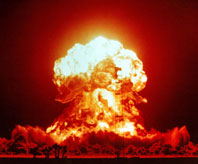
|
Heavy water provides a path to turn common uranium into
plutonium, one of the easily split or "fissile"
materials that fuels nuclear bombs.

|
|
|
|
|
What Countries Make It?
When Norsk Hydro began producing heavy water in 1934, Norway became
the first country with a commercial heavy-water plant. The Nazi
invasion of Norway in 1940 transferred control of the
plant—and most of the world's heavy water—to Germany. In
the early 1940s, Allied countries joined the race for heavy water,
and by 1944, the Manhattan Project had made 20 tons of the precious
liquid, more than enough to fill the first heavy-water nuclear
reactor.
America's atomic weapons program ultimately relied more on graphite
than on heavy water in nuclear reactors, but the United States has
continued to produce heavy water for military use ever since the
'40s. Today, Canada and India, which both rely on heavy-water
nuclear power plants for electricity, make the most heavy water.
Other countries with heavy-water production facilities include
Argentina, Iran, Romania, and Russia.
|
|
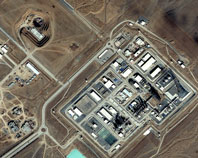
|
Satellite images taken in February 2005 reveal a
heavy-water plant in Arak, Iran. Iran claims the
facility will help the country produce electricity, not
plutonium for bombs.

|
|
|
|
|
How Was it Discovered?
In 1913, chemists Arthur Lamb and Richard Leen at New York
University tried to find a definitive value for the density of pure
water, but despite meticulous experiments, they kept getting varying
results. Their "failure" was, in retrospect, important evidence for
the existence both of heavy water and of isotopes—atoms of an
element that have the same number of protons but a different number
of neutrons and, therefore, different weights. That same year,
independently, the notion of an isotope was proposed for the first
time.
By 1931, the existence of isotopes was firmly established, and
Harold Urey at Columbia University, together with colleague George
Murphy, first glimpsed hydrogen's heavier isotope deuterium using a
technology called spectroscopy. They later distilled deuterium from
liquid hydrogen, clinching proof of its existence. Urey won the
Nobel Prize in Chemistry in 1934 for discovering deuterium, the key
component of heavy water.
|
|
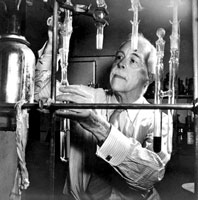
|
Gilbert Lewis, a renowned chemist at U.C. Berkeley,
isolated the first sample of essentially pure heavy
water from ordinary water in 1933.

|
|
|
|
|
How is it Made?
Heavy water is naturally present in ordinary water, so it's more
accurate to speak of "isolating" rather than "making" it. Separating
out significant quantities, though, is no easy trick because heavy
water constitutes only one part in 4,500. Gilbert Lewis isolated the
first samples in 1933 using electrolysis—sending an electric
current through water to separate it into its elements. His
technique relied on the fact that H20 breaks apart more
readily than D20, and the residual water left after
electrolysis is relatively rich in D20. By reprocessing
the residual water over and over again, he could eventually purify
heavy water. With his lab equipment, however, Lewis's process was
time-consuming and expensive.
Norsk Hydro, which already used electrolytic cells in the early
1930s to make fertilizer, seized the chance to make heavy water on
an industrial scale. By 1935, the Norwegian company was shipping
heavy water to scientists throughout Europe who wanted it for
physics, chemistry, and biomedical research. Today, heavy water is
isolated in a variety of ways, including a distillation method akin
to making brandy from wine. Other methods exploit the different
affinities that deuterium and hydrogen have for various compounds.
|
|
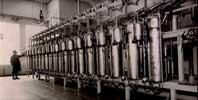
|
After the Nazis took control of the Norsk Hydro plant in
1940, they expanded the number of electrolytic cells
from nine to 18, doubling the plant's production of
heavy water.

|
|
|
| |
|
|


|

|
| |
|
|
|

